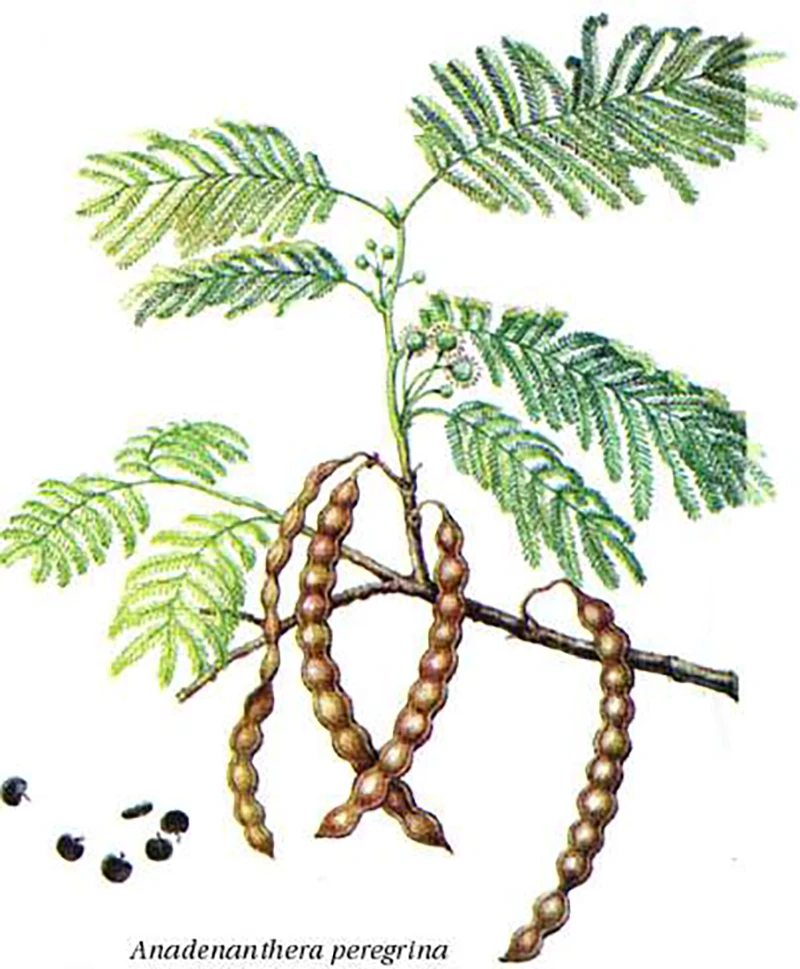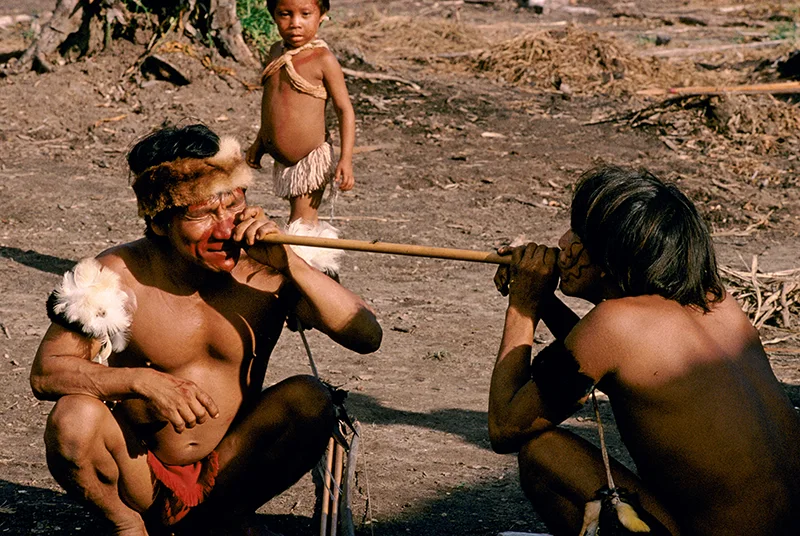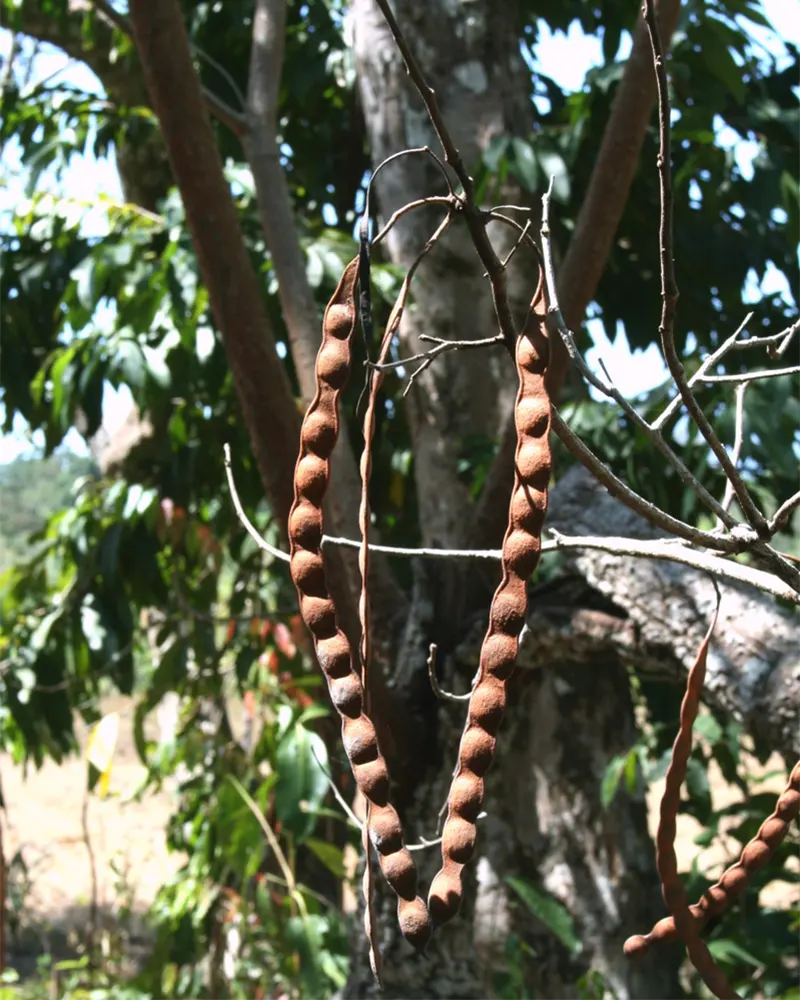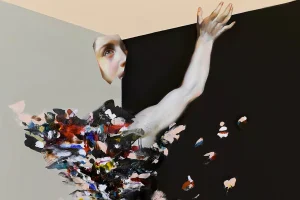“It’s a healing of the body and soul,” says Hortimio. He’s talking about yopo, a mixture of Amazonian plants traditionally used as snuff. Hortimio is a Piaroa community leader and land defender in his thirties. He lives far outside of cell service. We’ve been playing a game of telephone for weeks when he suddenly answers his phone on his motorbike en route to the hospital with his ten-month-old daughter. In the middle of it all, he begins to share how his people, the Huottüja in their native language, could lose their land and “everything that has to do with the practice of shamanism, healing and the management of ancestral medicine.”
Yopo snuff is made from the seeds of the Anandenanthera peregrina tree. It contains three powerful psychedelic compounds: bufotenin (5-HO-DMT), 5-MeO-DMT, and N, N-DMT. In Piaroa communities, the snuff is forcibly blown or sucked up your nostrils with a bamboo or birdbone pipe. No one knows exactly how long the tradition has been alive in Piaroa communities, who have long called banks and tributaries of the Orinoco River, which flows through modern-day Venezuela and Colombia, their home. Lately, their traditional territory has taken on a different name: the “Orinoco Mining Arc.”
President Nicolás Maduro designated the region—a Portugal-sized section of the Amazon rainforest—a “strategic development zone” in 2016, hoping to increase Venezuela’s mineral exports amid growing economic crisis. Venezuela is South America’s largest petroleum producer, but the country has faced a decline in both oil production and cost, as well as sanctions imposed by the United States after Maduro’s re-election in 2018.
Hortimio and others warn that the psychoactive snuff and their cultural traditions exist in a precarious state. The same fertile soil that breathes life into A. peregrina and the dense canopy of the Amazon is also rich in gold, diamonds, and other minerals like coltan, which is used in electronic devices. “All of this is being lost because of globalization; the new generation is no longer interested because this globalization, this culture, has imposed itself more than ever; it is contaminating our culture,” he says.
What is Yopo, the Plant?
A. peregrina and its nearly identical cousin Anandenanthera colubrina have a wide distribution throughout the Orinoco basin and beyond, likely from humans transporting seeds. Within the Orinoco region, the trees flourish in the tropical savannah “cerrado” environment that stretches into Brazil, where the tree is commonly known as angico and paricá. The trees also grow well in the Caribbean. According to ethnobotanist Richard Evans Schultes, the plant was likely spread around other parts of South America by invaders from the Orinoco. Reaching over 20 meters (60 feet) the trees have a rough horn-like bark and produce clusters of white flowers before dropping large amounts of seed pods resembling beans.
Ethnobotanist Johnathan Ott writes in Pharmacotheon that the primary alkaloid in A. peregrina is bufotenin, with smaller amounts of 5-MeO-DMT and N, N-DMT. Bufotenin and 5-MeO-DMT are potent psychedelic compounds also found in the secretions of the Sonoran Desert Toad. All compounds are naturally occurring tryptamines, like psilocybin found in magic mushrooms. Yet, unlike psilocybin mushrooms, the yopo experience can involve intense visuals, as well as a “purge,” which often causes vomiting.
READ: Mining and Poaching Threatens 15,000-Year-Old Peyote Tradition in Mexico

Illustration of Anadenanthera peregrina (Yopo) | via Wikimedia Commons
It’s widely accepted that bufotenin is the main psychedelic in yopo, but there are conflicting analyses, explains computational neurobiologist Dr. Andrew Gallimore via Twitter. Alkaloid concentrations vary by species, as well as which part of the plant is used (the pods contain N, N-DMT) along with the maturity of seeds, with seedlings appearing to have more N, N-DMT). Indeed, Piaroa shamans carefully choose “good” trees over “bad.” They harvest at specific times during the year and travel great distances to their favorite trees or areas.
How to Grow Shrooms Bundle
Take Both of Our Courses and Save $90!
Preparation is another factor that influences psychoactivity. “Yopo is known as Ñua, and to feel the effects, it has to be used in combination of an MAOI, this is known as Tuipa,” says Andres Martinez, a native Venezuelan who has worked with the yopo for over seventeen years. “It is important to note that these names come from the Piaroa language.” Tuipa is the Piaroa name for the ayahuasca vine.
Yopo preparation can have many specific steps, explains Robin Rodd, an Associate Professor of Anthropology at Duke Kunshan University. He completed anthropological fieldwork while living with the Piaroa for about 18 months between 1999 and 2001. Making the snuff often involves beans, tree bark turned to ash for alkaline additive, and the ayahuasca vine. However, even if one manages to gather all necessary materials, Rodd’s paper suggests it’s more than mere chemistry. “The maker’s aesthetics of motion relate to the degree to which the end product takes the maker, in turn, on a smooth voyage and the extent to which the shaman can demonstrate self-control under duress.”
When taking yopo with a Piaroa shaman it’s often mixed with Tuipa, which is said to make the experience longer and more intense. This is because of MAOI (monoamine oxidase inhibitors) found in the ayahuasca vine, Banisteriposis caapi. In the jungle, the ayahuasca vine is used (among other things) as a vehicle to potentiate the effects of other plants. A well-known example is the combination of ayahuasca vine and chacruna leaves (Psychotria viridis) for the ayahuasca brew. Chacruna contains N, N-DMT, but without MAOI the human body can’t use it. Yopo is similar. Ott published self-experiments suggesting 5-MeO-DMT and bufotenin could be psychoactive on their own, but when an MAOI enters the mix, the psychedelic experience becomes more powerful.
The Yopo Experience
“It was an experience I won’t ever forget,” says Martinez. In 2011, he tried yopo with a Meñerua for the first time. Meñerua are Guardians, a local name for Piaroa shamans. Already acquainted with Colombian yagè, Martinez had been organizing the ceremonies through a Venezuelan NGO in what he calls “the urban shamanism movement.” But he felt something was still missing.
Martinez says that the Piaroa are Guardians of the antique yopo tradition; yopo is called the Grandfather of the Jungle. He recounts his first yopo experience consisted of “a super smart, clever, fast and visual spirit showing me a kind of black screen like a cinema.” Then, “Through the clearest visions I can remember, these images reminded me of some scenes of the Minority Report movie.”

“Since that experience, my complete life changed; in my heart, I knew I had found the way, the purpose, and the mission of my life.” After this first yopo experience, “I began to learn,” he says. He now studies with Piaroa in Amazonia and now helps organize ceremonies with Piaroa shamans internationally. Martinez is always careful to emphasize where the medicine comes from. “There are other Indigenous peoples who use this medicine, too, but usually, these tribes live very far in the jungle, mostly in Venezuela, Brazil, and Colombia. Each community and each shaman have their own design, their own customs, and traditions. Their own cosmovision.”
A Very Brief History of Yopo Snuff
The Orinoco basin is by no means the only place snuffs are used. In fact, evidence of great enthusiasm for snuffs has been found throughout ancient Mesoamerica. Early grave sites reveal people buried with their snuff paraphernalia, such as ornately carved trays for inhaling snuff. Smoking pipes made from the Puma bone have been found with traces of DMT in them, perhaps dating beyond 2000 BC. With smoking the beans being documented from various sources and, if the carbon dating is correct, the use of Anandenanthera could be more than 4000 thousand years old.
Through Spanish chroniclers, we know the Taíno people of the Caribbean used cohoba, also made from A. peregrina. Further South, A. colubrina is still in use as a snuff called villca, wilka, or cebil. Archeologists can trace the use of the snuffs back to pre-Inca Tiwanaku and Wari civilizations too, and it’s likely the Inca used villca too, based on evidence collected across the ancient empire stretching throughout South America. Epená is another powerful snuff made throughout Amazonia from a red resin containing DMT and 5-MeO-DMT harvested from vriola trees. While we might assume this means snuffs were popular, we aren’t sure, with some analysis suggesting only a small number of people ingesting truely psychedelic types.
Yet, despite its long pre-colonial history, yopo has not received the same attention in the west as other plant medicines. Tobacco-based snuffs like rapè or hapè are growing in popularity, while countless other plants across the many tribes of Amazonia are added into the mix. Some examples include powdered coca leaf, cacao beans, and aromatics we might find in the kitchen. However, the well of plant knowledge remains deep in South America, with a significant number of plants still unGoogleable.

The current status of these plants cannot be divorced from the impact of colonialism. During colonization, the Spanish demonized the snuffs. Jesuit Priest Joseph Gumilla, author of El Orinoco Ilustrado y Defendido, wrote of the “most evil habit of intoxicating themselves through the nostrils,” and he associated yopo with “the ingenuity of the devil.” Missionaries stamped out snuff completely in many regions; for example, Cohoba is no longer used throughout the Caribbean. However, thanks to the work of elders and shamans over generations, traditions prevail. Tension still exists between Indigenous and missionary groups in the Amazon, tucked within various pockets of South America, guardians like Piaroa keep snuff traditions alive.
Yopo and Wilka Traditions
“It is a study from the beginning,” says Hortimio, who describes yopo as an escalation process leading to the realization and management of ones spirituality. “[The shamans] experimented on me so I could be approved. After approval, one becomes like a chieftain, like a young fighter, like a young defender.”
“In general, yopo tradition is a sacred rituality used by the shaman of the tribe and shared with the leaders, warriors, hunters, or sick people under a specific healing or strengthening ceremony,” says Martinez. “Each tribe and each shaman have received their knowledge from their ancestors and older shamans.”
“I mean, there are healing rituals,” says Rodd. “The shaman takes yopo. The yopo helps him understand and diagnose the problem, look into the patient. There is this whole sense of the body as some sort of an energy field.” He recounts how shamans worked on patients remotely. “[Yopo] isn’t simply about gaining information about something or understanding a situation, but about manipulating it.” Rodd explains that there is “a capacity to transform in a more interventionist sense, and that’s where that’s where the sorcery, as well as malevolent behaviour, comes into it.”

Yopo, like ayahuasca, is utilized for not only healing but also shamanic warfare. Rodd participated in a battle to save the village from sorcery with the shaman he was apprenticed to, Don Jose Luis. Detailed in Piaroa Sorcery and the Navigation Effect, Rodd describes using yopo for visions contributing to the defense of a village under attack by a malicious shaman. While chewing ayahuasca vine to enhance perception and potentiate the effects of yopo, Rodd does battle with his huräruä, a shamanic pig tusk weapon, to defend against Märi, malicious spirits working on behalf of an enemy sorcerer. “There are other agents, of course, lifeforms, some of whom happen to be these other shamans, and others happen to be our spirits that you want to avoid.”
Amazonia is a complex world. Relationships of cause and effect exist between plants, animals, rivers, and mountains, each with its own story and character. Rodd writes, “Training to use yopo is a process of learning to see relationships among people, the environment, and feelings.” Piaroa shamans learn to navigate all this with “Maripa” which is an “orienting knowledge of the forces that underlie death, life, change, causation, and existence in the Piaroa world.”
How to Grow Shrooms Bundle
Take Both of Our Courses and Save $90!
“It was always about someone or someplace or some animal. But generally about some or some relationship, a person that lived there that we were trying to understand.” Rodd says the approach to yopo was far less about individual experience and more relational. When Don Jose Luis heals a village from sorcery, he interviews nearly the entire town for a general mood and social dynamics while using yopo to divine necessary details. “Part of the work that they’re doing all the time is keeping tabs on everyone and understanding how people are.”
Preserving the Future of Yopo & The Guardians
“For us, being here in the jungle, we always know our position is for the defense of the territory, for the defense of culture. Because with this globalization we see that the ancestral knowledge is already being lost,” says Hortimio.
A report prepared for the 40th Session of the United Nations Human Rights Council suggests that, despite constitutional laws guaranteeing protections for Indigenous peoples in Venezuela, increased mining operations are destroying large sections of the Amazon rainforest, the traditional lands of many Indigenous communities. The UN report cites evidence that the area has also attracted criminal organizations who operate mines illegally.
Martinez discusses another factor. “Younger generations are leaving their territories to move to the cities,” he says, “Fortunately, there are still a few young apprentices that are learning from the hands of The Guardians of their traditions in order to keep and protect the spirit of the Grandfather of the Jungle.”

A representative from the Huottüja Foundation commented they think yopo use is increasing and that some communities are moving away from Christianity, which for years actively sought to convert Indigenous away from shamanism. The Huottüja Foundation seeks to bring economic opportunity to the region. Their projects involve local cacao, plant medicine ecotourism, and perhaps even artisanal yopo. The foundation is one of many Orinnoco-based projects seeking to leverage intellectual property rights for potential new opportunities for Piaroa to protect their traditions.
When I ask Rodd what he thinks the future of yopo he acknowledges it’s a complex situation. It’s clear, too, that Rodd’s time studying with Don Jose Luis left an impact. “The medicalization of psychedelics is completely irrelevant to these sorts of questions. I mean, it asks questions and goes about studying these things in ways that are completely not useful for understanding what I would consider to be the main basis of the practice and the core experiences that they generate.”
Despite countless challenges surrounding the preservation of yopo traditions, Martinez carries confidence and belief in the medicine. “I understand the yopo still awaits to go out and meet the Western society through the hand of the real Guardians of the tradition….and this moment is not far to come.”
For Hortimio, yopo is part of the land that he will continue to protect with his organization, Pueblo Unido Huottöja de Cuenca del Río Cataniapo (OPUS). “We are sure that this organization will defend its territory for the happiness, for the peace of this people.” Our conversation ends as he hurries inside the hospital to treat his daughter. I ask what is next, he responds, “The idea is to experience it; as the philosopher said, no, philosophy is not about thought but about living in philosophy, walking in it.”

DoubleBlind is a trusted resource for news, evidence-based education, and reporting on psychedelics. We work with leading medical professionals, scientific researchers, journalists, mycologists, indigenous stewards, and cultural pioneers. Read about our editorial policy and fact-checking process here.

DoubleBlind Magazine does not encourage or condone any illegal activities, including but not limited to the use of illegal substances. We do not provide mental health, clinical, or medical services. We are not a substitute for medical, psychological, or psychiatric diagnosis, treatment, or advice. If you are in a crisis or if you or any other person may be in danger or experiencing a mental health emergency, immediately call 911 or your local emergency resources. If you are considering suicide, please call 988 to connect with the National Suicide Prevention Lifeline.



